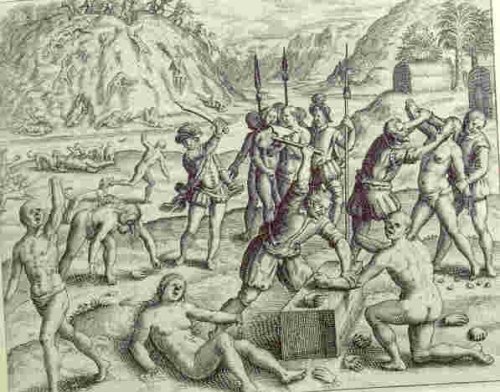(Or, How to Treat Those Who Are in Your Way, Actually or Potentially)
Several of us are beginning to make our way through Howard Zinn’s A People’s History of the United States. A couple of weeks ago, we read the chapter on “Columbus, the Indians, and Progress.” Reading the testimony of Father Las Casas reminded me of a more recent period of our history, that of the 1980s when the U.S. government was supporting the El Salvadoran government with a million dollars a day. Father Daniel Santiago bore witness to the “aesthetics of terror” of those the U.S. backed with such munificence and dedication. Father Jon Sobrino would have been murdered with his brother Jesuits and university staff and family had he not been out of the country on November 16, 1989.
1.
From that time onward the Indians began to seek ways to throw the Christians [i.e., Spaniards] out of their lands. They took up arms, but their weapons were very weak and of little service in offense and still less in defense. (Because of this, the wars of the Indians against each other are little more than games played by children.) And the Christians, with their horses and swords and pikes began to carry out massacres and strange cruelties against them. They attacked the towns and spared neither the children nor the aged nor pregnant women nor women in childbed, not only stabbing and dismembering them but cutting them to pieces as if dealing with sheep in the slaughter house. They laid bets as to who, with one stroke of the sword, could split a man in two or could cut off his head or spill out hsi entrails with a single stroke of the pike. They took infants from their mothers’ breasts, snatching them by the arms and pitching them headfirst against the crags or snatched them by the arms and threw them into the rivers, roaring with laughter and saying as the babies fell into the water, “Boil there, you offspring of the devil!”
–Father Bartolome De Las Casas, 1542
2.
The Salvadoran armed forces also had a different aesthetic than the guerrillas. They did not just kill; they killed with style.
Return to the massacre of Toñita’s family, it takes effort to decapitate old men and small children. It takes imagination to arrange their torsos around the table as if about to share a feast of their own blood. This was only one tableau of many. Other scenes macabres were created by the armed forces in their twelve year exhibition of horror and death.
People were not just killed by death squads in El Salvador—they were decapitated and then their heads were placed on pikes and used to dot the landscape.
Men were not just disemboweled by the Salvadoran treasury police; their severed genitalia were stuffed into their mouths.
Salvadoran women were not just raped by the national guard; their wombs were cut from their bodies and used to cover their faces.
It was not enough to kill children; they were dragged over barbed wire until the flesh fell from their bones while parents were forced to watch.
— Fr. Daniel Santiago, 1993
3.
The crucified people are one of the main features of our time, not merely something factual that we may consider, but something central that must be considered, without which we do not have full grasp on reality.
— Fr. Jon Sobrino, 2007

An illustration by Theodore De Bry for Bartolome de Las Casas’s Short Account of the Destruction of the Indies